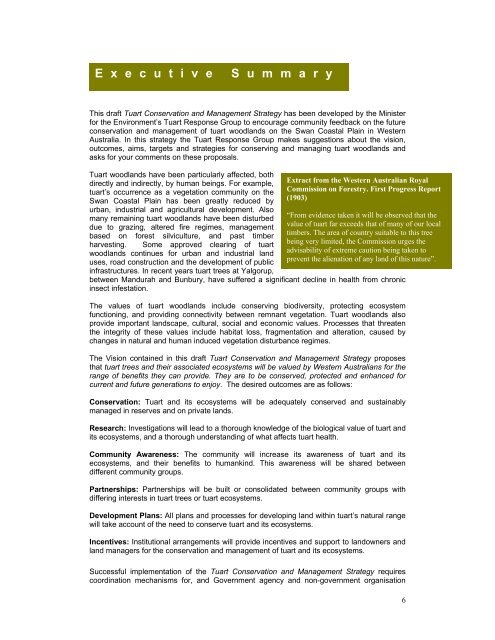DRAFT Tuart Conservation and Management Strategy
DRAFT Tuart Conservation and Management Strategy
DRAFT Tuart Conservation and Management Strategy
You also want an ePaper? Increase the reach of your titles
YUMPU automatically turns print PDFs into web optimized ePapers that Google loves.
E x e c u t i v e S u m m a r y<br />
This draft <strong>Tuart</strong> <strong>Conservation</strong> <strong>and</strong> <strong>Management</strong> <strong>Strategy</strong> has been developed by the Minister<br />
for the Environment’s <strong>Tuart</strong> Response Group to encourage community feedback on the future<br />
conservation <strong>and</strong> management of tuart woodl<strong>and</strong>s on the Swan Coastal Plain in Western<br />
Australia. In this strategy the <strong>Tuart</strong> Response Group makes suggestions about the vision,<br />
outcomes, aims, targets <strong>and</strong> strategies for conserving <strong>and</strong> managing tuart woodl<strong>and</strong>s <strong>and</strong><br />
asks for your comments on these proposals.<br />
<strong>Tuart</strong> woodl<strong>and</strong>s have been particularly affected, both<br />
directly <strong>and</strong> indirectly, by human beings. For example,<br />
tuart’s occurrence as a vegetation community on the<br />
Swan Coastal Plain has been greatly reduced by<br />
urban, industrial <strong>and</strong> agricultural development. Also<br />
many remaining tuart woodl<strong>and</strong>s have been disturbed<br />
due to grazing, altered fire regimes, management<br />
based on forest silviculture, <strong>and</strong> past timber<br />
harvesting. Some approved clearing of tuart<br />
woodl<strong>and</strong>s continues for urban <strong>and</strong> industrial l<strong>and</strong><br />
uses, road construction <strong>and</strong> the development of public<br />
infrastructures. In recent years tuart trees at Yalgorup,<br />
Extract from the Western Australian Royal<br />
Commission on Forestry. First Progress Report<br />
(1903)<br />
“From evidence taken it will be observed that the<br />
value of tuart far exceeds that of many of our local<br />
timbers. The area of country suitable to this tree<br />
being very limited, the Commission urges the<br />
advisability of extreme caution being taken to<br />
prevent the alienation of any l<strong>and</strong> of this nature”.<br />
between M<strong>and</strong>urah <strong>and</strong> Bunbury, have suffered a significant decline in health from chronic<br />
insect infestation.<br />
The values of tuart woodl<strong>and</strong>s include conserving biodiversity, protecting ecosystem<br />
functioning, <strong>and</strong> providing connectivity between remnant vegetation. <strong>Tuart</strong> woodl<strong>and</strong>s also<br />
provide important l<strong>and</strong>scape, cultural, social <strong>and</strong> economic values. Processes that threaten<br />
the integrity of these values include habitat loss, fragmentation <strong>and</strong> alteration, caused by<br />
changes in natural <strong>and</strong> human induced vegetation disturbance regimes.<br />
The Vision contained in this draft <strong>Tuart</strong> <strong>Conservation</strong> <strong>and</strong> <strong>Management</strong> <strong>Strategy</strong> proposes<br />
that tuart trees <strong>and</strong> their associated ecosystems will be valued by Western Australians for the<br />
range of benefits they can provide. They are to be conserved, protected <strong>and</strong> enhanced for<br />
current <strong>and</strong> future generations to enjoy. The desired outcomes are as follows:<br />
<strong>Conservation</strong>: <strong>Tuart</strong> <strong>and</strong> its ecosystems will be adequately conserved <strong>and</strong> sustainably<br />
managed in reserves <strong>and</strong> on private l<strong>and</strong>s.<br />
Research: Investigations will lead to a thorough knowledge of the biological value of tuart <strong>and</strong><br />
its ecosystems, <strong>and</strong> a thorough underst<strong>and</strong>ing of what affects tuart health.<br />
Community Awareness: The community will increase its awareness of tuart <strong>and</strong> its<br />
ecosystems, <strong>and</strong> their benefits to humankind. This awareness will be shared between<br />
different community groups.<br />
Partnerships: Partnerships will be built or consolidated between community groups with<br />
differing interests in tuart trees or tuart ecosystems.<br />
Development Plans: All plans <strong>and</strong> processes for developing l<strong>and</strong> within tuart’s natural range<br />
will take account of the need to conserve tuart <strong>and</strong> its ecosystems.<br />
Incentives: Institutional arrangements will provide incentives <strong>and</strong> support to l<strong>and</strong>owners <strong>and</strong><br />
l<strong>and</strong> managers for the conservation <strong>and</strong> management of tuart <strong>and</strong> its ecosystems.<br />
Successful implementation of the <strong>Tuart</strong> <strong>Conservation</strong> <strong>and</strong> <strong>Management</strong> <strong>Strategy</strong> requires<br />
coordination mechanisms for, <strong>and</strong> Government agency <strong>and</strong> non-government organisation<br />
6

















